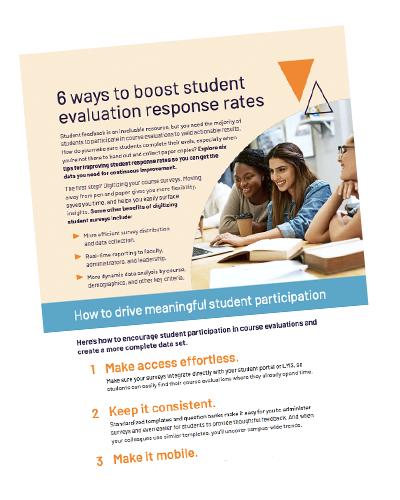Make sure your surveys integrate directly with your student portal or LMS, so students can easily find their course evaluations where they already spend time.
6 Ways to Boost Student Response Rates

Student feedback is an invaluable resource, but you need the majority of students to participate in course evaluations to yield actionable results. How do you make sure students complete their evals, especially when you’re not there to hand out and collect paper copies? Explore six tips for improving student response rates so you can get the data you need for continuous improvement.
The first step? Digitizing your course surveys. Moving away from pen and paper gives you more flexibility,saves you time, and helps you easily surface insights. Some other benefits of digitizing student surveys include:
- More efficient survey distribution and data collection.
- Real-time reporting to faculty, administrators, and leadership.
- More dynamic data analysis by course, demographics, and other key criteria.
6 ways to boost student evaluation response rates
Download Now

Standardized templates and question banks make it easy for you to administer surveys and even easier for students to provide thoughtful feedback. And when your colleagues use similar templates, you’ll uncover campus-wide trends.
Put your survey in the palm of their hands. Find a survey tool that works great on any device, so students can participate anywhere, anytime. Easy access = higher response rates.
Students may be more likely to click a link in an email than respond to a pop-up in their LMS. Give them multiple (automated) reminders and direct, authenticated access to the survey – no jumping through hoops required.
No survey, no grade. If your policies allow it, use your digital evaluation tool to gain close to 100% response rates by withholding access to assignments or grades until the task is complete.
Let students review the results of specific survey questions. They’ll see how their input stacks up against their classmates, and you’ll demonstrate your institution’s commitment to improvement based on what matters most: your students.

Let Watermark Support Your Response Rate Strategies
Watermark Course Evaluations & Surveys is purpose-built for higher education and offers a rich set of features to help you achieve your response rate goals. With turnkey LMS integrations for Blackboard, Canvas, D2L, Moodle, and more, we can get you up and running quickly and give you access to the data you need to answer big-picture questions and make meaningful improvements.




